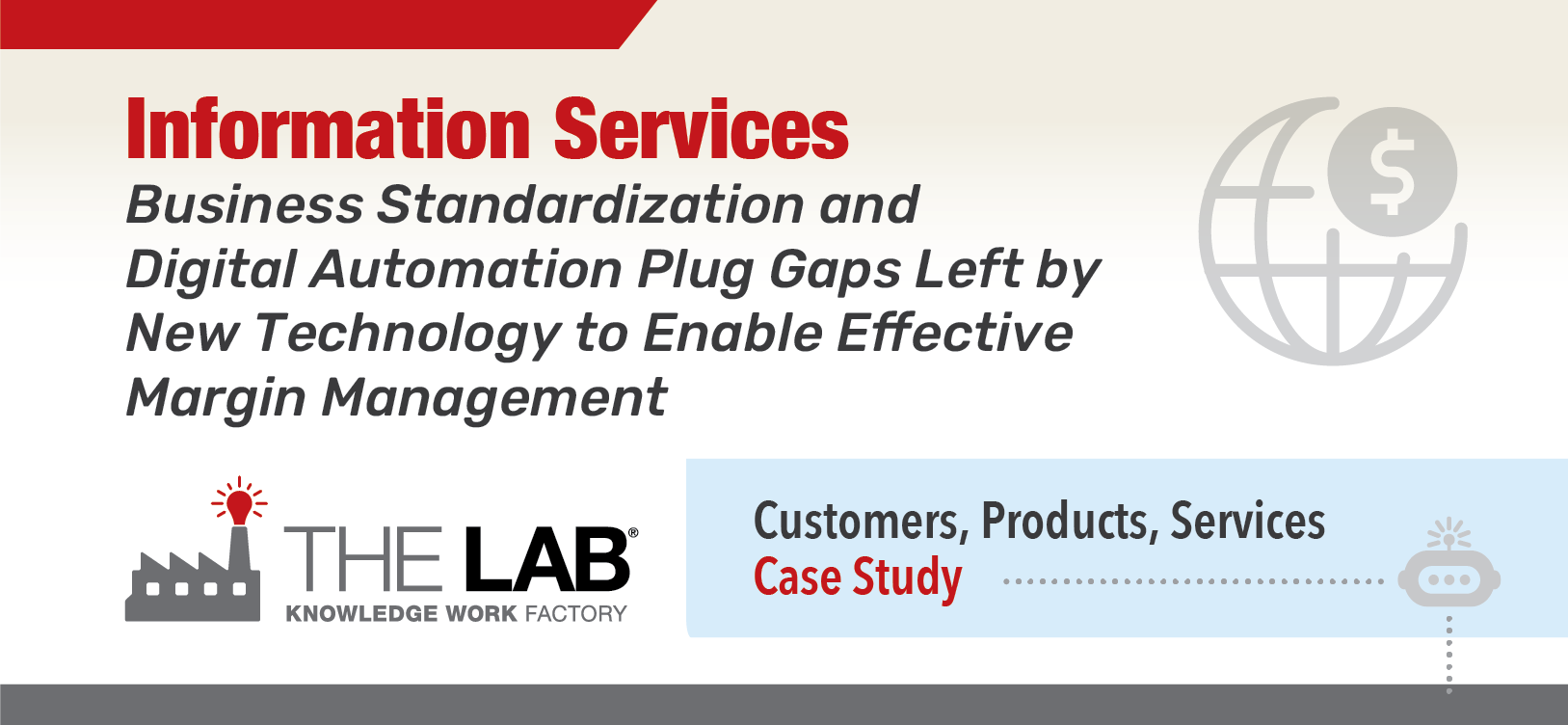Situation
For decades, this company called itself an “information provider,” serving the global pharmaceuticals industry. After several major acquisitions broadened its market footprint across the entire healthcare sector, steady growth far exceeded original expectations. It rebranded itself as a “research and advisory firm,” delivering standard “products” as well as customized “management consulting” services. Management and employees considered the business a success.
But in recent years, margin growth lagged revenue gains, and external shareholders grew restless. Finally, under pressure from activist investors, the COO launched a costly, core-technology-transformation initiative that promised lower costs, productivity gains, improvements in customer self-service, and continuous digital-automation capabilities. But 18 months after completion, nothing much had changed, and margin growth was still lackluster.
While visiting frontline employees, the COO was stunned by all the manual work required. Workers still used their familiar spreadsheets, uploading to the new system only after they had completed their individual tasks. Virtually none of the IT initiative’s promised benefits could be seen.
The work didn’t move “seamlessly” throughout the organization on a single workflow platform. Employees performed manual data transfers and reconciliations of under-standardized formats for customer and product information. Profitability, or margin data—promised for customers, products, and services—was not available.
Perhaps most disappointing, the leading-edge, fully-featured, customer relationship management (CRM) application seemed to be used simply as a replacement for the old customer info database.
The COO had understood that this new CRM “toolset” would help provide “one face to the customer,” coordinating everything from sales prospecting to segmented service levels for customers based on their profitability and total value.
Any questions from the COO were met with overwhelming assurances from execs that, “we’re on it, and will have it soon.” He contacted The Lab for objective, rapid documentation of end-to-end business processes, overall performance, and near-term, feasible opportunities to make the most of existing assets and technologies.
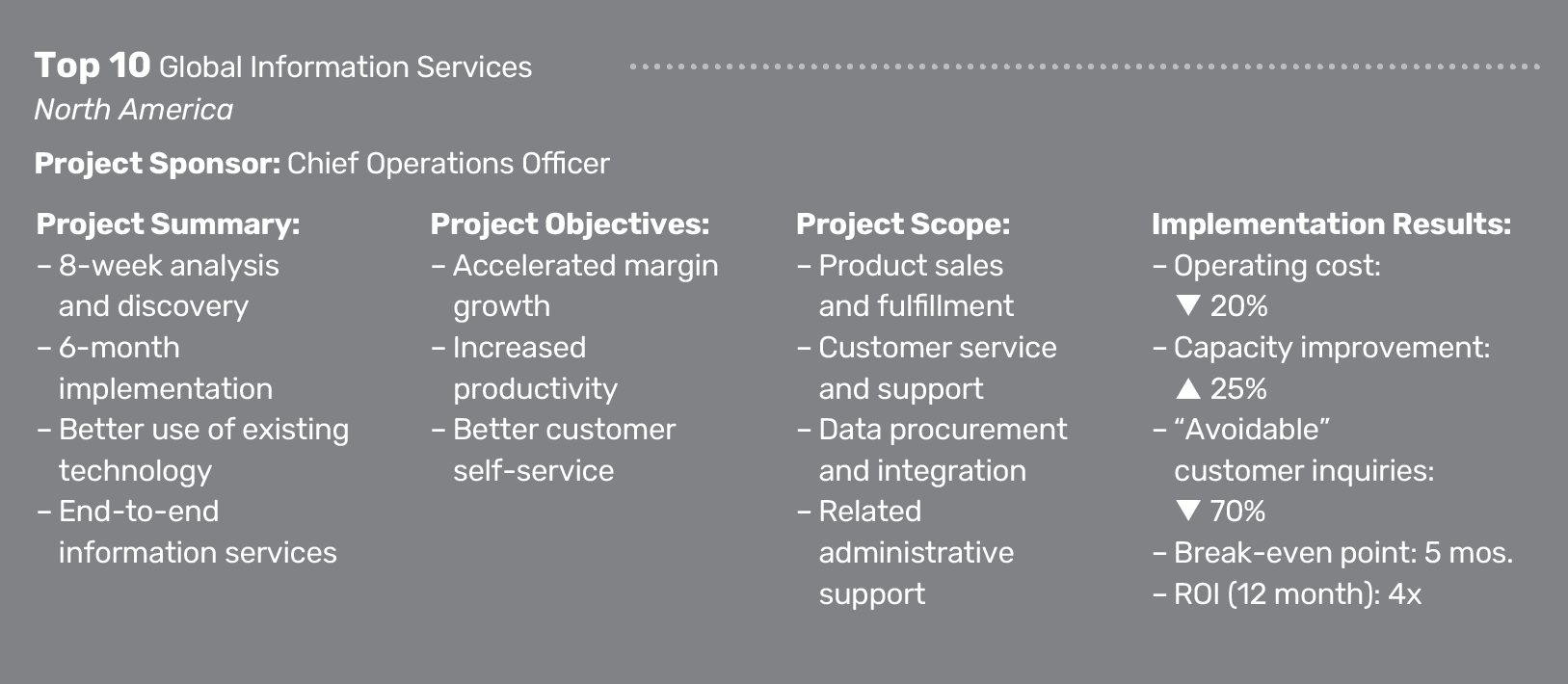
Client Description, Project Scope, Objectives
A Top 10 global provider of information services, the company employs 35,000 people.
The Lab’s first initiative focused on operations in North America, covering approximately 4,000 employees. Later, these findings were used as “templates” to accelerate analysis of other locations and businesses.
The Phase I project scope was “end-to-end,” starting with sales prospecting, extending through all aspects of fulfillment, customer service, partnership administration (data sources), compliance, billing, collections, and various administrative support functions.
The primary objective targeted rapid assessment of the division for the COO with pragmatic proposals to support the ongoing board-level discussions for improving enterprise-wide margins and shareholder value.
The COO wanted to move beyond the financial-engineering proposals of the activists and unlock the business value inherent in existing operations—and the recently-deployed new technology. His travels throughout the organization convinced him that these existing, intangible assets were under-used and undervalued.
Overview: Phase I, Analysis and Discovery
The initiative began with an eight-week Phase I analysis covering end-to-end operations and business processes, including:
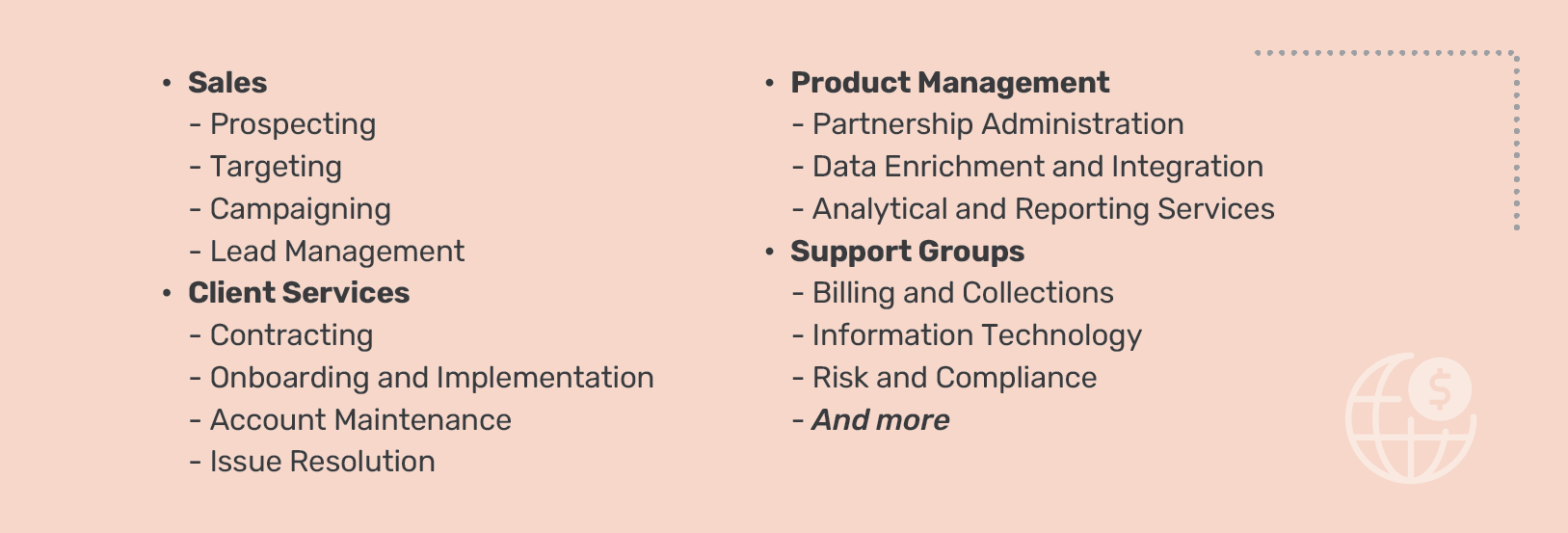
The Lab deployed our proprietary information-services standardization templates, including:
- Industry-standard KPIs
- Related data taxonomies
- Business process maps
- Operations benchmarks
- Best practices
- Automation “use cases”
- And more
These enable rapid, remote documentation and analysis of more than 85 percent of employee work activities (approximately two minutes each), while only requiring one hour per week of any subject matter expert’s (SME’s) time.
The analysis was first conducted in jointly selected, representative client offices across North America. The business process maps, standardization improvement inventories, automation candidates, and regional best practices were documented for these initial locations and then “gap tested” among other client offices performing similar work. This frugal analytical approach documented more than 200 total improvements in just eight weeks.
Roughly 40 percent of these were non-technology standardization improvements that boosted operational effectiveness, reduced avoidable rework, and/or enabled automation. The remaining improvements were technology-dependent, but the new core system included most of the necessary features—these simply weren’t used because of the human work effort required to gather the information.
The Lab documented scores of automation candidates to absorb the tedious work of transcribing information and improve use of the most valuable features of existing technology: profitability calculation, lead management, real-time operational performance reporting, and automated alerts.
Better yet, all improvements could begin implementation immediately. Progress could be achieved incrementally, without the risk of a “big-bang” event. Each area could proceed at their own pace as part of a coordinated, transformational roadmap.
Findings: Phase I, Analysis and Discovery
More than 300 improvements were documented during the eight-week Phase I work effort. These were grouped into four major improvement themes designed to standardize business processes and work activities, provide insights to improve profitability, increase the use of existing technology, and implement valuable automations.
1. Standardization. Work was perceived as “standardized,” but opportunities still existed to increase the existing levels of precision to eliminate corrective rework and increase the levels of automation.
For example, entry-level employees spent a third of each workday reconciling similar data from different internal sources. Costly senior employees in the advisory business spent a similar portion of their day on avoidable data “wrangling” tasks. These manual activities added costs to the products in a highly competitive marketplace.
2. Margin measurement. Margins for products, customers, and revenue producers were analyzed rarely and only on a one-off basis— typically generating internal debates. Although negative margins existed in all segments, the costliest were found where “custom” scope and pricing were involved. Custom pricing varied by 3x to 5x for similar work efforts and products.
Routine measurement and reporting, however, provided immediate benefits. This could enable standardization of work definitions and automation of the pricing process in the existing CRM.
3. Existing system adjustments. The business implications—both advantages and disadvantages—of the recently-deployed CRM application received minimal attention from both business employees and the IT staff.
Example: A pricing tool was available in the CRM that could reduce variation that currently eroded margins on 15 percent of advisory studies. Complexity and unfamiliarity discouraged its use—while RPA bots could easily automate it.
4. New digital automations. The client’s internal Center of Excellence (COE) teams struggled to identify automation use-cases. The Lab’s catalog of robotic process automation (RPA) use-cases, combined with the structured business-process-map checklist, identified more than 100 applicable, high-value use-cases.

Overview: Phase II, Standardization Implementation
A six-month, self-funding, enterprise-wide Phase II implementation overcame the gaps left by installation of the new core technology and fulfilled the promise of “one face to the customer.”
The Phase II work effort delivered more than 300 improvements, organized into two major categories:
1. Standardization improvements:
- Pre-empted “custom” analytics requests from clients
- Reduced avoidable rework previously required to clarify these requests
2. Automations and advanced analytics:
- Tied together incompatible systems
- Converted data from incompatible sources into a standard format
- Centralized data into a master repository of:
– Customers
– Products
– Markets
- Provided a single, internal “view of the customer,” strategically designed to support more effective:
– Cross-selling
– Up-selling
– Servicing
– Margin management
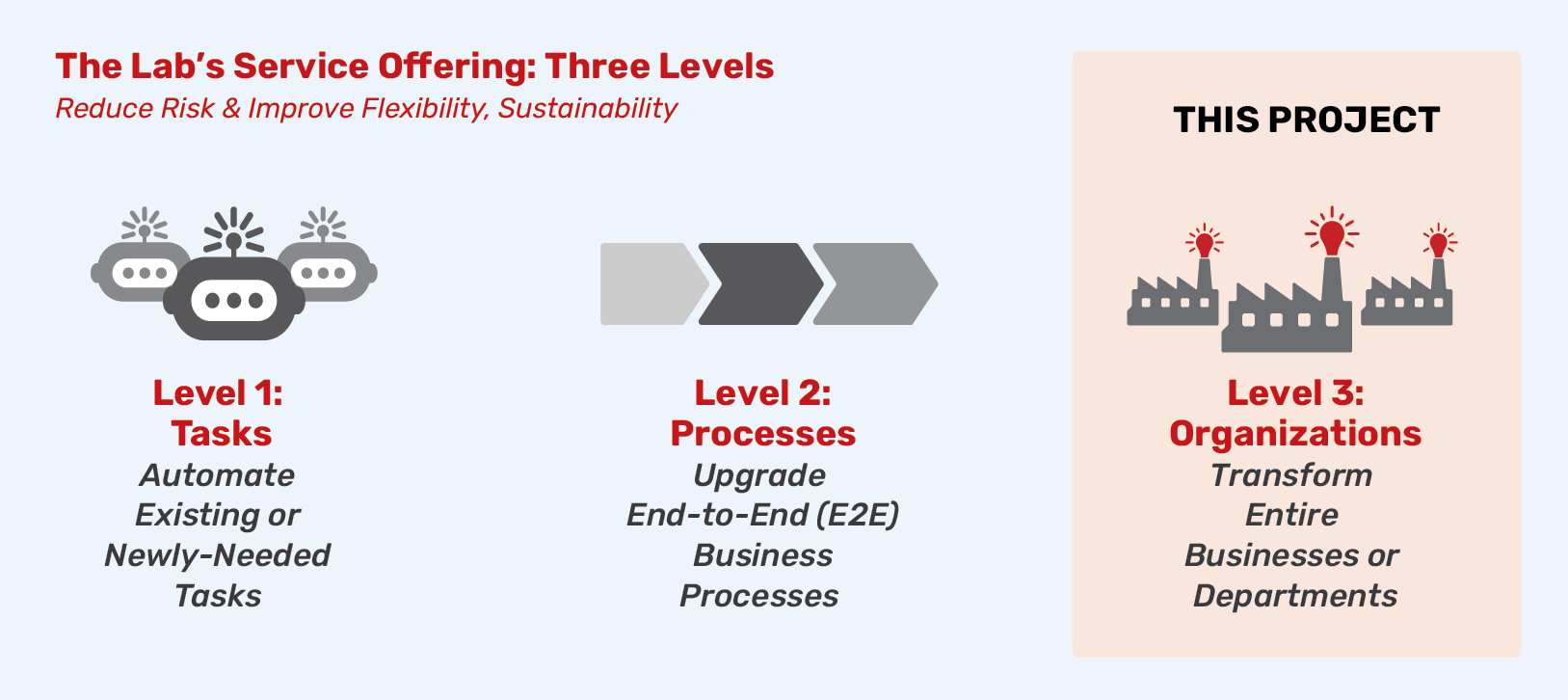
Information Services Improvement Examples: Phase II, Standardization Implementation
The Lab implemented more than 300 standardization improvements, best practices, and automations. Examples:
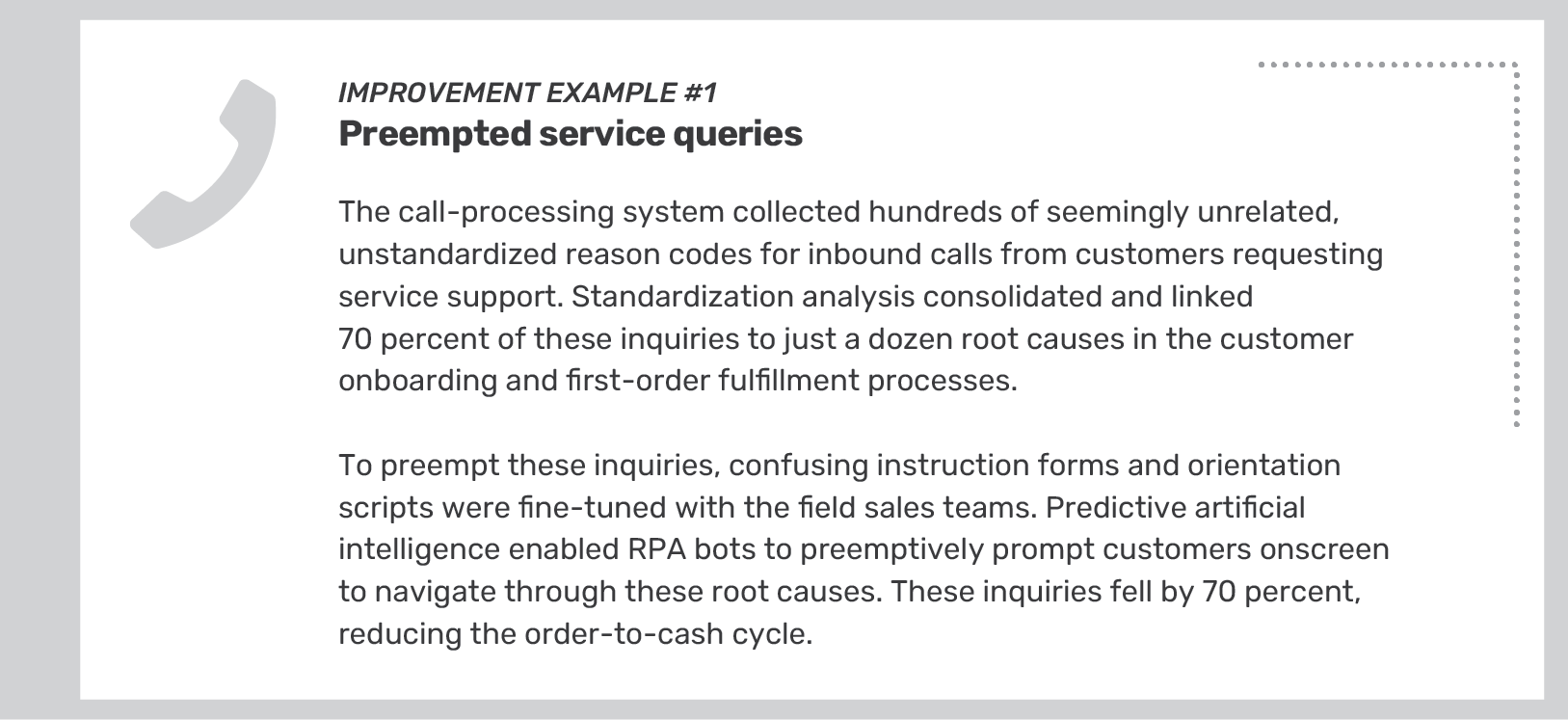
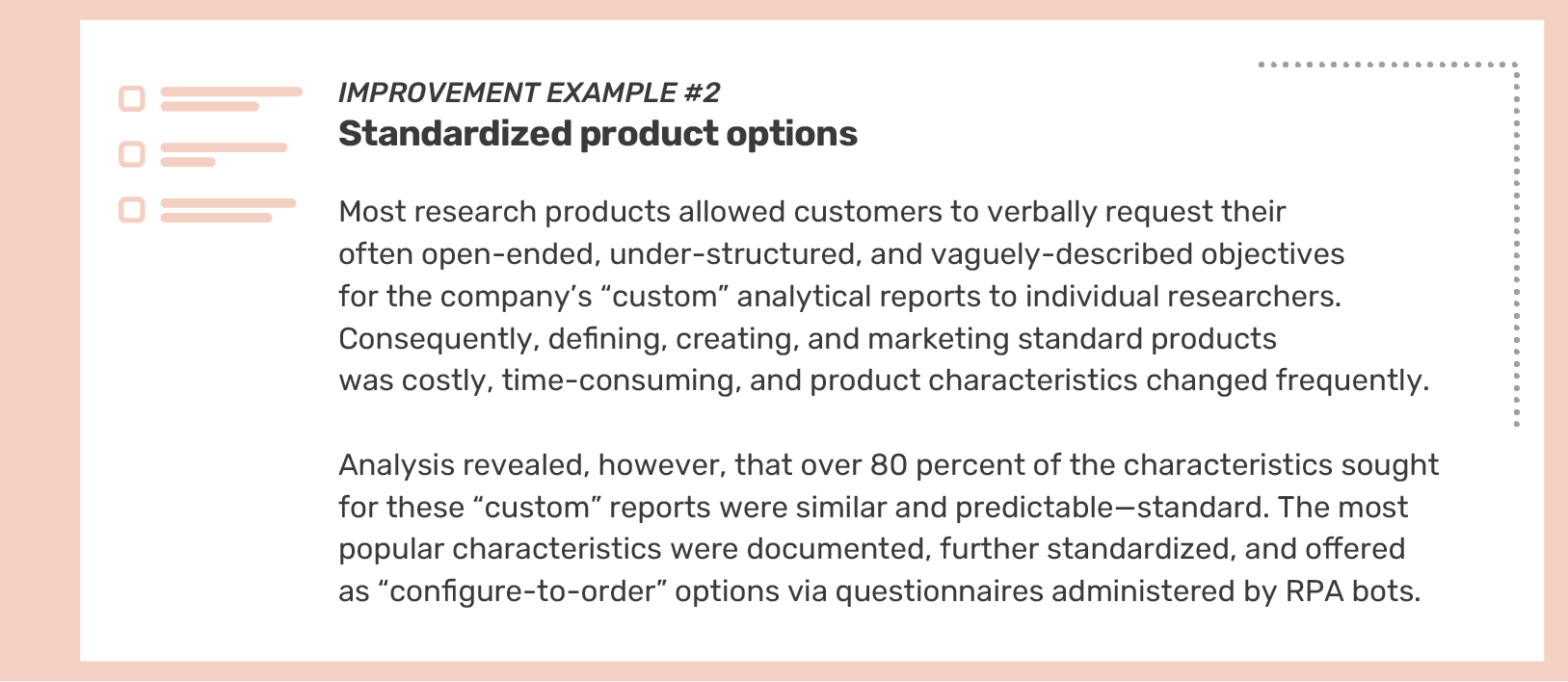
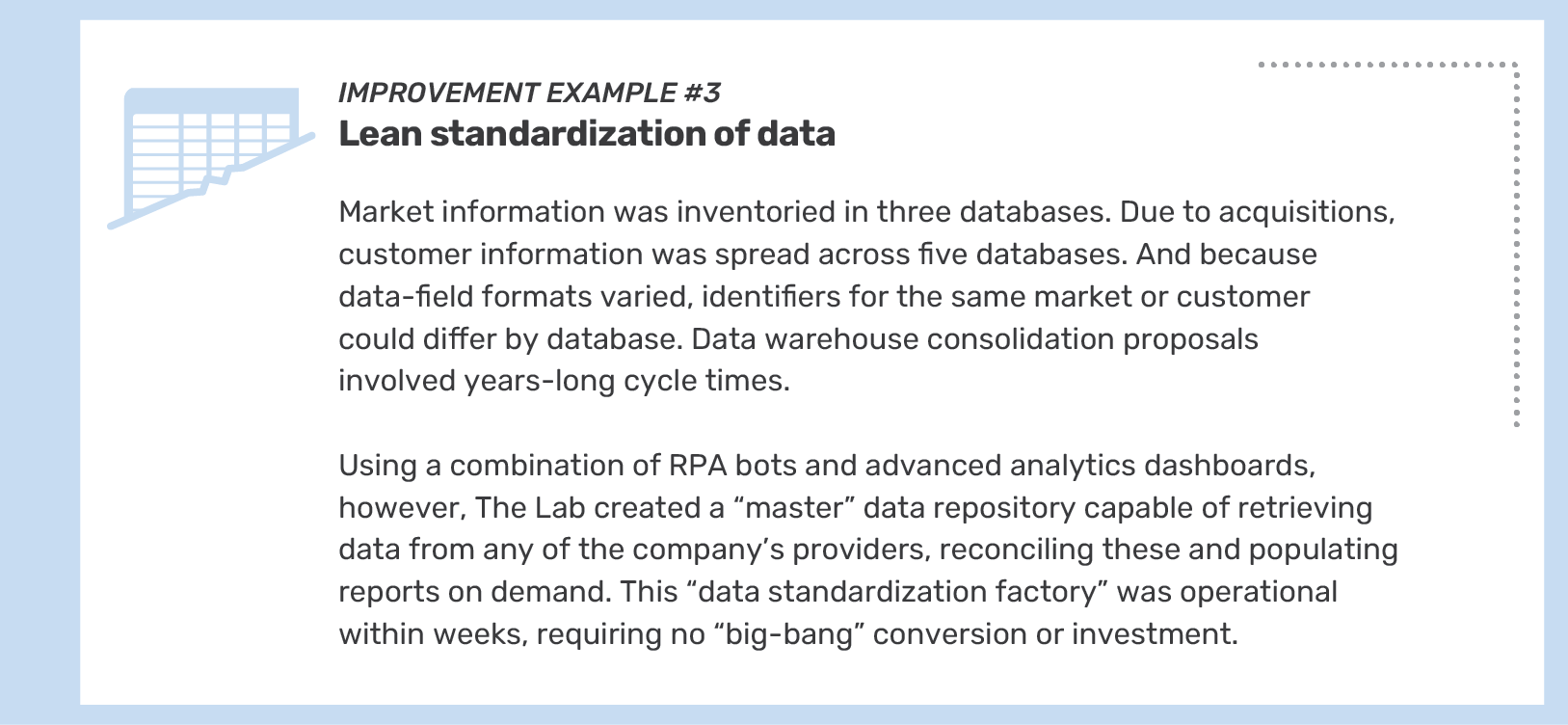
Post-Implementation Support, Sustainability & Automation
The Lab provided hassle-free, post-implementation hourly sustainability support for this client to maintain automations, process standardization, and operational data analytics models implemented during the Phase II engagement.
If the client’s team was not up-skilled enough to perform any needed automation updates, they leaned on The Lab for Tier 3-level support. If analytics dashboards required additional views or data connected, The Lab’s team was a simple phone call away.
The Lab Makes it Easy
Organization-friendly engagement design
At The Lab, we’ve spent three decades refining every aspect of our transformation engagement model. We’ve made it easy for clients—from the C-Suite to the front line—to understand and manage the initiative:
• Minimal use of client time: One to two hours each week, maximum.
• Measurable benefits: Typical 12-month ROI is 3x to 5x.
• Pre-built templates and tools: Process maps, data models, bots, and more.
• U.S.-based, remote delivery: Nothing is ever outsourced or offshored.
Designed to reduce risk, increase success
Since 1993, The Lab has led the industry in eliminating risk for our clients. Whether your engagement involves a handful of bots or wall-to-wall transformation, we make it easy to do business with us:
• Fixed pricing and clearly defined scope
• Pre-project feasibility/value assessments at nominal cost
• Early-out checkpoints and options
• Money-back guarantees
Book your free demo
The best way to learn about The Lab’s patented Knowledge Work Standardization® approach is to book your free, no-obligation 30-minute screen-sharing demo. And you’ll get all your questions answered by our friendly experts. Simply call (201) 526-1200 or email info@thelabconsulting.com to book your demo today!
















